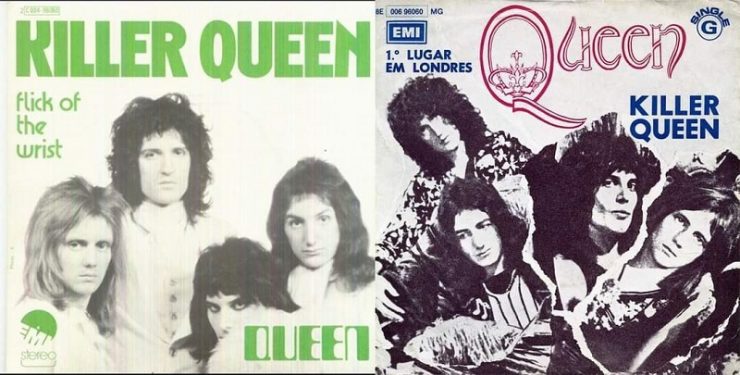QUEEN released their single ‘Killer Queen’ on October 21, 1974. It was their first international hit, reaching number two in the UK and becoming their first US hit. The song was written by Freddie Mercury, recorded for their third album Sheer Heart Attack.
The song is about a high-class call girl. It has been characterized as “Mercury’s piano-led paean to a Moet-quaffing courtesan”.
When released as a single, “Killer Queen” was Queen’s breakthrough hit, reaching number two in the United Kingdom and number twelve in the United States. It was released as a double A-side in the United Kingdom, the United States and Canada (where it reached number 15 on the national RPM 100 singles chart), with the song “Flick of the Wrist”. In 1986, it featured as the B-side to “Who Wants to Live Forever”.
The song marked a transition from the heavier material of the band’s first two albums, as well as the beginning of a more stylistically diverse approach to songwriting. At the same time, “Killer Queen” retains the essence of Queen’s signature sound, especially in the meticulous vocal harmonies.
Mercury commented that he wrote his lyrics before the melody and music, whereas normally he would do the opposite. The recording features intricate four-part harmonies (especially in the chorus, and also provides supporting parts in the verses), as well as a multitracked guitar solo by Brian May that utilizes a bell effect. The song’s first verse quotes a phrase wrongly attributed to Marie Antoinette: “Let them eat cake,” she says, just like Marie Antoinette.
In addition to using a grand piano as usual, Mercury overdubbed the song with an upright piano to give the song a vaudeville sound. At one point there are two different bass guitar grooves, one of which is diverging downhill. Unlike the first two Queen albums, this song was partly recorded at Rockfield Studios in Wales.
Freddie Mercury: “People are used to hard rock, energy music from Queen, but with this single you almost expect Noel Coward to sing it. It’s one of those bowler hat, black suspender belt numbers – not what Coward would wear.”
“It’s about a high-class call girl. I’m trying to say that people who are classy can be prostitutes too. That’s what this song is about, although I prefer people to interpret it – to read into it what they like.”
Brian May: “Killer Queen was the turning point. It’s the song that best sums up our kind of music, and a big hit, and we really needed it as a sign of something successful happening for us…” I’ve always been very happy with this song. The whole record was made in a very craftsman-like way.”
“I still love listening to it because there’s so much to listen to, but it never gets cluttered. There’s always room for all the little ideas to pop up. And of course, I love the solos, with the three-part section, where each part has its own voice. What can I say?”
This is vintage Queen. The first time I heard Freddie play that song, I was lying in my room at Rockfield [a home recording studio in Wales], feeling very sick. After the first Queen tour in America, I had hepatitis, and then I had really bad stomach problems and I had to have surgery.
So, I remember just lying there, hearing Freddie play this really great song and feeling sad, because I thought, ‘I can’t even get out of bed to participate in this. Maybe this group will go on without me.
‘ Nobody knew what was wrong with me. But then I went to the hospital and I recovered, thank God. And when I came out again, we managed to finish ‘Killer Queen.’ They left some space for me and I did a solo. I had a strong feeling about one of the harmony parts in the chorus, so we had to do the same.”
The song was regularly performed between 1974 and 1981 as part of a medley. In 1974-75, it was played after “In the Lap of the Gods”, and in 1975-76, it followed “Bohemian Rhapsody”. In 1984 and 1985, during The Works Tour, the song was reintroduced in a medley after a truncated version of “Somebody to Love”.
The third verse and chorus of this song were never performed live. This song won her first Mercury Ivor Novello Award.
“Killer Queen” has been described by AllMusic as the true beginning of Queen’s “radio sound” and “recalls the cabaret songs of the past, but also shows how Queen quickly became a master of power pop”. Rock historian Paul Fowles wrote that “Killer Queen”, with its “sleazy Parisian imagery”, allowed “freedom” for Mercury’s “unique brand of rock theater”.
Katy Perry cites “Killer Queen” as an important influence on her. She said: “Queen’s song ‘Killer Queen’ made me discover music and helped me become myself at the age of 15. The way Freddie Mercury delivered his lyrics really made me feel like a confident woman.”
Personnel: Freddie Mercury – lead vocals and backing vocals, grand piano, tack piano, finger snapping, Brian May – electric guitar, backing vocals, Roger Taylor – drums, triangle, chimes, backing vocals, John Deacon – bass guitar. [sources/photo special]
















